When we arrived in Tucson, we made our reservations to visit in the evening on a night with a full moon. Big mistake - next time I’d go on a night with just a sliver of a moon - the stars are more visible them. We were supposed to be there by 5:30 and the program ended at 9:30. But, we figured, if we’re there anyway, why not go early and take in one of the daytime programs, too. And, so, we found ourselves leaving Tucson at 9:30 a.m. for the 2 1/2 hour drive to Kitt and getting back at 11:50 p.m. Long day but educational and fun.
As we neared Kitt Peak, we could see this pure white round knob over the mountain. Visible from miles away. It is the Mayall 4-m telescope. Pretty stunning atop the Peak surrounded by others.
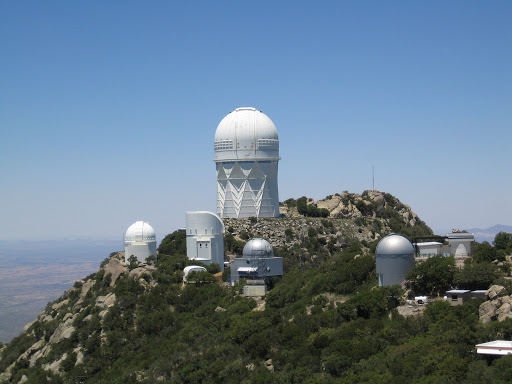

When we got there we had a bit of time to walk around and went to see the McMath-Pierce Solar Telescope, the largest solar telescope in the world. Stunning shape. The main structure that you can see is a tower nearly 100’ high from which a shaft slants 200’ to the ground. Then the shaft continues another 300’ in the ground. It’s used to study sun spots.


We laughed when we saw the control panel for this telescope. Such an old arrangement. So 1960’s. But, if it works, why replace it?

Inside we saw that some astronauts had visited: Alan Shepard, Scott Carpenter, Wally Schirra, Gordon Cooper, Ed White. Household names when we were growing up.

a model of the telescope with the brown panel being the ground. You can see how far it goes into the ground.
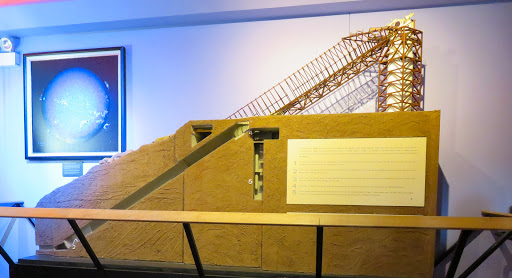
Stunning views from the top of the mountain here.
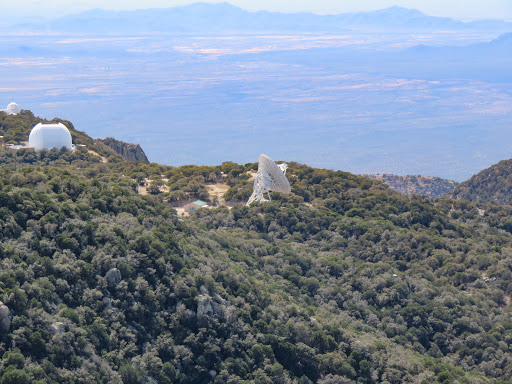
Our first tour was of the Mayall 4-m telescope, the tall one in the first pictures above. Our guide was a wealth of information and entertained us with stories for the whole 1/4 mile walk to it. My favorite story was how they got the long steel pipes that form the framework up the hill, which is a mountain road with loads of tight switchbacks. They were put on a truck and a crane followed it up the hill. When the truck got to a curve, it stopped, the crane lifted the ends of the pipes, held them as the truck rounded the curve and then put them back down on the flat bed of the truck. I wish the above pictures which I got from the Kitt Peak website had a person in them so you could see just how big this observatory is: 18 stories tall. The dome is a double shell structure and is able to withstand 120 mph winds.
It was erected in 1973 and is the largest optical telescope on Kitt Peak. We got to go inside the building but not into the actual telescope area although we could see it through the glass.

The round structure is the mirror.
I suppose I never thought looking at stars as a historical observation. But, of course, they are light years away. One of the stars we looked at was 3000 light years away or: we were looking at what the star looked like 3000 years ago. If the sun is 8 light minutes away, it really sets 8 minutes earlier than I saw. Hmmm. Let me wrap my head around that. You’re never looking at the sun in real time, it’s always 8 minutes ago.
We had a chance to walk around a bit and saw the petroglyphs they had discovered on the Peak and wanted to preserve. The glare from the sun almost obscured them.
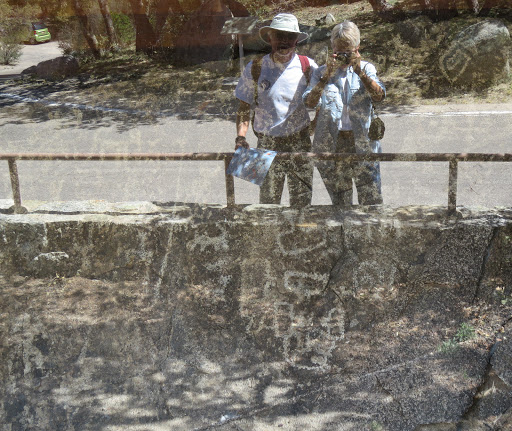
Since the astronomers work at night, this sign was only appropriate. ‘Day Sleepers, Quiet Please.’
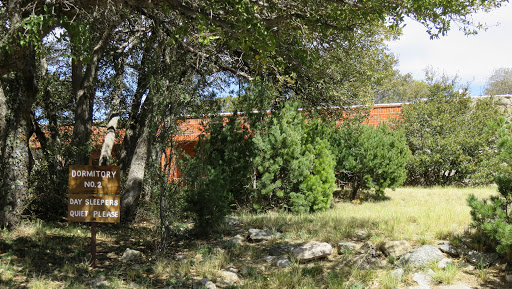
It looks as if the people on this mountain are not interested in basketball. They have their priorities.

After our tour, we headed to our car for a ‘snack’ before dinner. We hadn’t eaten since breakfast and we were hungry. As we were eating a light snack, we noticed that a young man had lined his van up strangely in the parking lot. Then he came over to us and asked up to line up right in back of him and all the other cars lined up in back of us. Then he covered all of our front lights, leaving the red back lights uncovered.

We checked out the bathrooms next - which were pretty dim because they were lit with red lights.
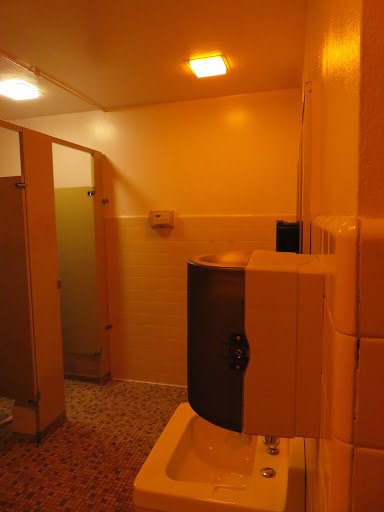
Then we went into the Visitor Center to tour it and see the displays. Here’s a picture of us in negative. Hmm. I’ve forgotten what this has to do with astronomy.

Finally for our evening observatory time. We first had a small dinner while the tour guide told us about the evening, the observatory, and a lot about what the astronomers studied here. He also gave us tiny plastic red light flashlights to use as we walked around outside. We then walked out side and looked one direction to see the sunset and then the opposite direction to see the moon rise. I liked the glow of the sun on the Mayall.

We were in the first group to look through the telescopes. We went to another observatory in Texas once and it was a disappointing experience. The telescope was about 36” long, we were on a patio and the views were not very good. The telescope was small, the crowd was big, the views were fleeting and not very good. This experience at Kitt was much better: the telescope was huge, we were in an actual dome which opened and rotated and we got to spend as much time as we wanted to look through it. Pretty cool. Our guide chose a star, a nebula, a star that was being born and a star that was dying and finally the full moon. Each of these, except the moon, was further and further away from earth so we were going further and further into history.
The telescope was controlled by a computer. Our guide chose what he wanted us to see, keyed it into the computer and the computer moved the telescope around and up and down to key in on the star. No guesswork here. Modern technology. I was surprised to learn that old telescopes are just as good as new telescopes since they are really just mirrors. Now, of course the quality is just as good but they are getting bigger and bigger.
The second part of the night was not as exciting since we were using binoculars and looking at constellations. OK, but the observatory part was much more interesting - of course. And then, the full moon gobbled the stars and they were hard to see with our binoculars.
About those red lights: light pollution from white light is a problem for astronomers. City lights are an especially big problem and the reason why most observatories are located for away from cities. White lights pollute the sky, red lights do not. That’s why we had red flashlights and there were red lights in the bathrooms.
We could see the lights of Tucson from the top of Kitt but we could also see the lights of Phoenix, 2 hours north of Tucson and these were just as bright. How come? Most city lights have no lid on them and they shine up as much as they shine down. Well, the astronomers discussed the brightness of their lights with the Tucson City Council. At first the CC thought: why should they spend money to dim their lights for some astronomers on a peak about 90 miles south? Ah, well, what about the millions of dollars spent in Tucson every year by those at Kitt Peak visiting astronomers and tourists? Ah, good argument and Tucson has lights that aim downward, they have lids on them. Whereas the lights of Phoenix do not.

There are so many telescopes on Kitt Peak that your chances of getting to use one for your studies is pretty good, 1 out of 4 gets a shot. Write a proposal and submit it. Good luck.
Fun day and we’d recommend you take these tours if you are in the Tucson area. Here we are in front of a model for one of mirrors in a telescope. They use a model like this for positioning in the observatory so they don’t break the actual mirror.

Since telescopes are so expensive, most are bought by a collaborative of universities. Here are the universities who participated in building the telescopes on Kitt Peak. Hey, Iowa State is here.


No comments:
Post a Comment